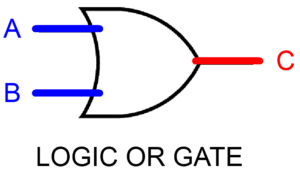Understanding Digital Electronics: An Overview
Introduction
Digital electronics, a pivotal field within electrical engineering, focuses on circuits and devices designed to process digital signals. Unlike analog electronics, which handle continuous signals, digital electronics deal with discrete signals, typically represented in binary form (0s and 1s). This distinction forms the bedrock of modern technology, enabling the development and functioning of computers, smartphones, and a myriad of other digital devices that define our era.
The Binary System
At the heart of digital electronics is the binary number system. Unlike the decimal system, which uses ten digits (0-9), the binary system uses only two digits: 0 and 1. These digits correspond to the off (0) and on (1) states of a digital circuit. Each binary digit, or bit, can represent two states, and a group of eight bits forms a byte, the basic unit of data in digital systems. This simplicity allows for complex computations and data processing to be broken down into manageable steps for a digital processor.
Logic Gates and Circuits
Logic gates are the fundamental building blocks of digital circuits. These gates perform basic logical functions, and when combined, they can execute complex operations. The most common logic gates include AND, OR, NOT, NAND, NOR, XOR, and XNOR. Each gate has a specific function:
AND Gate: Outputs a high signal (1) only if all its inputs are high.
OR Gate: Outputs a high signal if at least one of its inputs is high.
NOT Gate: Inverts the input signal.
NAND Gate: Outputs a low signal only if all its inputs are high.
NOR Gate: Outputs a low signal if at least one of its inputs is high.
XOR Gate: Outputs a high signal if the inputs are different.
XNOR Gate: Outputs a high signal if the inputs are the same.
Combining these gates in various configurations allows the creation of complex circuits capable of performing arithmetic operations, data storage, and control tasks.
AND GATE
Function: The AND gate outputs a high signal (1) only when all its inputs are high
SYMBOL
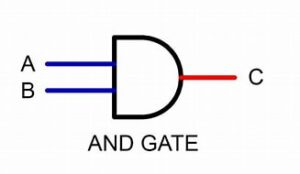
Truth table
| A | B | Y |
|---|---|---|
| 0 | 0 | 0 |
| 0 | 1 | 0 |
| 1 | 0 | 0 |
| 1 | 1 | 1 |
2. OR Gate
Function: The OR gate outputs a high signal if at least one of its inputs is high.
SYMBOL
Truth Table:
| A | B | Y |
|---|---|---|
| 0 | 0 | 0 |
| 0 | 1 | 1 |
| 1 | 0 | 1 |
| 1 | 1 | 1 |
3. NOT Gate
Function: The NOT gate outputs the inverse of the input signal.
Symbol:
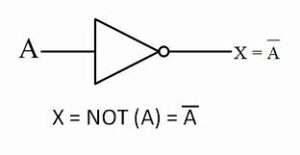
Truth Table:
| A | Y |
|---|---|
| 0 | 1 |
| 1 | 0 |
4. NAND Gate
Function: The NAND gate outputs a low signal (0) only when all its inputs are high. It is the inverse of the AND gate.
Symbol:
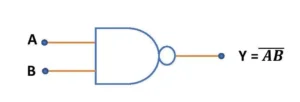
Truth Table:
| A | B | Y |
|---|---|---|
| 0 | 0 | 1 |
| 0 | 1 | 1 |
| 1 | 0 | 1 |
| 1 | 1 | 0 |
5. NOR Gate
Function: The NOR gate outputs a low signal if at least one of its inputs is high. It is the inverse of the OR gate.
Symbol:
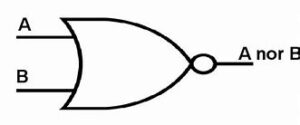
Truth Table:
| A | B | Y |
|---|---|---|
| 0 | 0 | 1 |
| 0 | 1 | 0 |
| 1 | 0 | 0 |
| 1 | 1 | 0 |
6. XOR Gate
Function: The XOR (Exclusive OR) gate outputs a high signal if the inputs are different.
Symbol:

Truth Table:
| A | B | Y |
|---|---|---|
| 0 | 0 | 0 |
| 0 | 1 | 1 |
| 1 | 0 | 1 |
| 1 | 1 | 0 |
7. XNOR Gate
Function: The XNOR (Exclusive NOR) gate outputs a high signal if the inputs are the same. It is the inverse of the XOR gate.
Symbol:
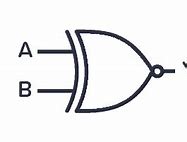
Truth Table:
| A | B | Y |
|---|---|---|
| 0 | 0 | 1 |
| 0 | 1 | 0 |
| 1 | 0 | 0 |
| 1 | 1 | 1 |
Flip-Flops
Flip-flops are essential components in digital electronics, serving as memory elements that can store binary data. They are used in various applications, including data storage, data transfer, and synchronization tasks within digital systems. Types of flip-flops include SR, JK, D, and T flip-flops, each with unique characteristics and applications. For instance, a D flip-flop, also known as a data or delay flip-flop, captures the value of the input data at a specific instance and stores it until the next clock pulse.
Types of Flip-Flops
SR (Set-Reset) Flip-Flop:
Operation: Has two inputs, S (Set) and R (Reset), and two outputs, Q and Q’ (Q prime). When S is 1 and R is 0, Q is set to 1. When S is 0 and R is 1, Q is reset to 0. When both S and R are 0, the state of Q remains unchanged. Both S and R being 1 is typically an invalid state.
Symbol:
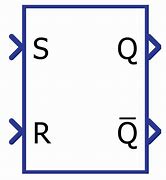
D (Data or Delay) Flip-Flop:
Operation: Has a single input D and a clock input. The output Q takes the value of D at the moment of the clock edge (rising or falling, depending on design).
Symbol:
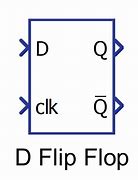
JK Flip-Flop:
Operation: Has two inputs, J and K, and a clock input. When both J and K are high, the output toggles. When J is high and K is low, Q is set. When J is low and K is high, Q is reset.
Symbol:
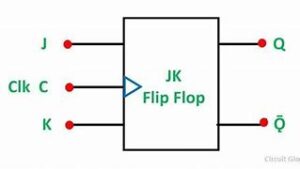
T (Toggle) Flip-Flop:
Operation: T flip-flop toggles its state when the T input is high at the clock edge
Symbol:

Applications of Digital Electronics Digital electronics have a wide range of applications across different industries:
Computers: The digital circuit is the heart of all computers. From the Central Processing Unit (CPU) to memory and input/output devices, digital electronics enable the processing, storage, and retrieval of data, making modern computing possible.
Communication Systems: Digital electronics play a crucial role in communication systems, including mobile phones, satellite communication, and the internet. Digital modulation techniques and error correction algorithms ensure reliable data transmission across various media.
Consumer Electronics: Devices like televisions, audio systems, digital cameras, and gaming consoles rely on digital electronics. These devices convert analog signals to digital form for processing, enhancing functionality and efficiency.
Automotive Industry: Modern vehicles incorporate digital systems for engine control, navigation, infotainment, and advanced driver-assistance systems (ADAS). These systems improve fuel efficiency, reduce emissions, and provide safer driving experiences.
Advantages of Digital Electronics
Noise Immunity: Digital signals are less susceptible to noise and distortion compared to analog signals, ensuring accurate data transmission and processing.
Ease of Design: Digital circuits are easier to design and simulate using software tools, allowing for quick prototyping and testing.
Scalability: Digital systems can be easily scaled up by integrating more components, enabling the development of complex and powerful devices.
Challenges in Digital Electronics
Power Consumption: Digital devices, especially large systems like data centers, consume significant power, necessitating efficient power management techniques to minimize energy consumption and operational costs.
Heat Dissipation: High-speed digital circuits generate heat, which must be effectively managed to prevent damage and ensure reliability. Advanced cooling solutions and thermal management strategies are crucial.
Complexity: As digital systems become more complex, designing, testing, and maintaining these systems pose significant challenges. Engineers must address issues related to signal integrity, timing, and component compatibility to ensure optimal performance.
Conclusion Digital electronics is a cornerstone of modern technology, impacting various aspects of our daily lives. From computing and communication to consumer electronics and automotive applications, its influence is vast and far-reaching. While it offers numerous advantages, it also presents challenges that drive ongoing innovation and advancements in the field. As technology continues to evolve, digital electronics will remain at the forefront, shaping the future of our digital world.
